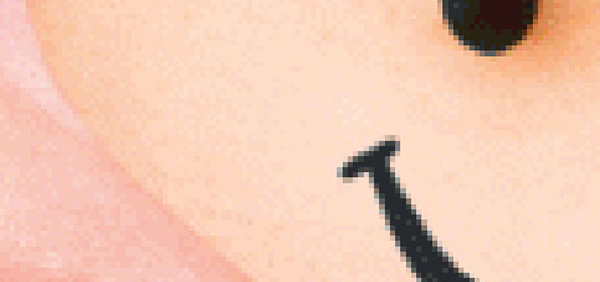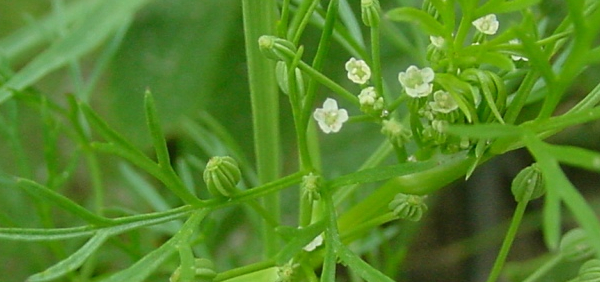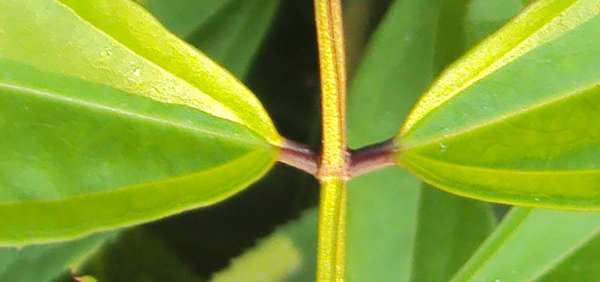apoedika :

Morphology:
The plant is a perennial twining herb. Stem is fleshy, stout at the base with slender upper branches. Leaves are axillary dark green, broadly ovate in shape and acute. Flowers are sub sessile, white, pink or red coloured and closed at anthesis. Bracts are scaly and small. Bracteoles are acute. Stamens are included with short filaments and cordate anthers. Ovary is unilocular. Fruit is black or dark purple coloured and enclosed within the persistent fleshy calyx. Seeds are black, globose and indehiscent.Histology:
T.S. of stem shows star shaped with five extended wings with single layer of epidermis, made up of parenchymatous cells covered by a thin layer of cuticle, followed by an epidermis of two to three layers. The hypodermis is composed of compactly arranged polygonal parenchymatous cells without any inter cellular spaces. Besides the hypodermis, cortex region is formed by 6-10 layers of compactly arranged polygonal thin walled parenchymatous cells followed by the cortex, 3-4 layers of compactly arranged sclerenchymatous layer of cells (pericycle), where vascular bundles are collateral, conjoint and closed. In the centre portion, pith region shows compactly arranged parenchymatous cells with simple and compound starch grains in groups and with clustered calcium oxalate crystals.T.S. of petiole is strongly convex and spherical on the lower side. A central narrow groove on the upper surface and two lateral narrow winged extensions on either side and shows a single layer of epidermis. Epidermis made up of single layer of rectangular cells covered with thin cuticle. It is followed by 8 to 10 layers of tangentially elongated thin walled parenchymatous cells forming the ground tissue. Calcium oxalate crystals abundantly present in this region. Most of the calcium oxalate crystals present in the narrow winged extensions and some crystals are present close to the vascular bundle region. The collateral meristele shows 3-7 vascular bundles that face each other laterally.
T.S. of the leaf through midrib region was convex at the lower side and grooved at the upper side, young leaf showed bicollateral meristeles in the centre, getting connected forming a single meristele encircled by a parenchymatous ring of pericycle in mature leaf. Parenchyma cells are 3-4 layers are in the narrow groove at the upper side, 5 to 6 layers towards the lower side. These cells are polygonal and compactly arranged without any air spaces. Clustered calcium oxalate crystals are present abundantly in the ground tissue region of the leaf. Most of the calcium oxalate crystals are present in the narrow winged extensions in laminar region, few crystals are also present close to meristele region. The single layered epidermis cells are rectangular, arranged compactly and covered by a thin cuticle and traversed with stomata. The laminar mesophyll region showed one to two layers of compactly arranged palisade parenchyma cells, two to four layers of loosely arranged spongy parenchyma cells, the calcium oxalate crystals were present abundantly in the upper layer of palisade parenchyma cells and were absent in the spongy parenchyma cells. Spongy parenchyma cells showed simple and compound starch grains in groups
- » Classification and names of apoedika
- » Synonyms and definitions of apoedika
- » Drug Properties of apoedika
- » Chemical Constituents of apoedika
- » Standardization of apoedika
- » Parts used and Dosage of apoedika
- » Morphology and Histology of apoedika
- » Distribution and Conservation of apoedika
- » Cultivation of apoedika
- » apoedika in the market
- » Medicinal Uses of apoedika
- » Researches and clinical trails of apoedika
- » apoedika in other sytems of medicine
- » Ayurvedic formulations with apoedika
- » Images of apoedika














